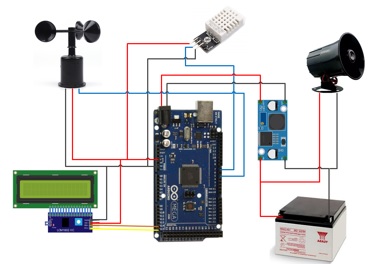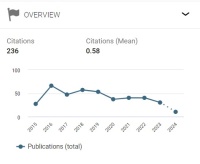Application of ANFIS in Decision-Making on the Smart Control Early Warning System for Tornadoes
Abstract
A tornado is one weather process that arises due to atmospheric instability. A tornado is a strong wind, but not all strong winds are tornadoes. Tornadoes have a short time frequency but can result in no minor disaster because they can blow objects away and uproot trees. Due to the consequences, an early warning system is needed as an anticipation for the community in the affected areas so that it can help the community by warning early on of the occurrence of a tornado. The ANFIS (Adaptive Neuro Fuzzy Inference System) method is used to forecast the event of a tornado, and the parameters used are wind speed, ambient temperature, and ambient humidity. This study will compare the ANFIS method using hybrid and backpropagation algorithms. Using the backpropagation algorithm, an error of 0.42385 was produced during training and testing, and an average error of 136.54 was obtained. When using the hybrid algorithm, the error during training is 2.0781 x 10-5, and the average error during testing is 0.015%.
Keywords — ANFIS ; Anemometer; DHT22; Early Warning System; Tornado.
Downloads
References
[2] J. Xu, J. He, and Q. Zeng, “Tornado Vortex Signature Recognition Algorithm based on Real-time Weather Radar Data,” in 2019 International Conference on Meteorology Observations (ICMO), 2019, pp. 1–3. doi: 10.1109/ICMO49322.2019.9026158.
[3] L. Wei, W. Yao, and G. Zhiqiang, “Analysis of the Effectiveness of Hainan Weather Radar Detecting Tornado,” in 2019 International Conference on Meteorology Observations (ICMO), 2019, pp. 1–4. doi: 10.1109/ICMO49322.2019.9026087.
[4] E. Avolio and M. M. Miglietta, “Tornadoes in the Tyrrhenian regions of the Italian peninsula: The case study of 28 July 2019,” Atmos Res, vol. 278, p. 106285, 2022, doi: https://doi.org/10.1016/j.atmosres.2022.106285.
[5] Z. Li et al., “Multivariate Analysis and Warning of a Tornado Embedded in Tropical Cyclone in Southern China,” IEEE J Sel Top Appl Earth Obs Remote Sens, vol. 14, pp. 11517–11529, 2021, doi: 10.1109/JSTARS.2021.3125269.
[6] L. Jun, Z. Honggen, L. Jianbing, and L. Xinan, “Research on the Networking Strategy of Tornado Observation Network in Northern Jiangsu Based on X-band Weather Radar,” in 2019 International Conference on Meteorology Observations (ICMO), 2019, pp. 1–4. doi: 10.1109/ICMO49322.2019.9026077.
[7] L. C. Feher, M. J. Osland, and C. Swarzenski, “Estuarine salinity extremes: Using the coastal salinity index to quantify the role of droughts, floods, hurricanes, and freshwater flow alteration,” Estuar Coast Shelf Sci, p. 108445, 2023, doi: https://doi.org/10.1016/j.ecss.2023.108445.
[8] M. Roldán, R. D. Montoya, J. D. Rios, and Andrés. F. Osorio, “Modified parametric hurricane wind model to improve the asymmetry in the region of maximum winds,” Ocean Engineering, vol. 280, p. 114508, 2023, doi: https://doi.org/10.1016/j.oceaneng.2023.114508.
[9] D. K. Ghose, K. Tanaya, A. Sahoo, and U. Kumar, “Performance Evaluation of hybrid ANFIS model for Flood Prediction,” in 2022 8th International Conference on Advanced Computing and Communication Systems (ICACCS), 2022, pp. 772–777. doi: 10.1109/ICACCS54159.2022.9785002.
[10] T. İnan and A. F. BABA, “Prediction of Wind Speed Using Artificial Neural Networks and ANFIS Methods (Observation Buoy Example),” in 2020 Innovations in Intelligent Systems and Applications Conference (ASYU), 2020, pp. 1–5. doi: 10.1109/ASYU50717.2020.9259894.
[11] S. Sharma and R. Singla, “ANFIS Based-Kinematic Modeling of 2R Robotic Arm,” in 2023 10th International Conference on Signal Processing and Integrated Networks (SPIN), 2023, pp. 567–570. doi: 10.1109/SPIN57001.2023.10116154.
[12] P. Boonraksa, K. Palachai, P. Chotipintu, T. Chaisa-Ard, T. Boonraksa, and B. Marungsri, “Design and Simulation of MPPT for PV Systems using ANFIS Algorithm,” in 2023 International Electrical Engineering Congress (iEECON), 2023, pp. 425–428. doi: 10.1109/iEECON56657.2023.10126918.
[13] M. Fernando, L. Jasa, and R. S. Hartati, “Monitoring System Kecepatan dan Arah Angin Berbasis Internet of Things (IoT) Menggunakan Raspberry Pi 3,” Majalah Ilmiah Teknologi Elektro, vol. 21, no. 1, p. 135, Jul. 2022, doi: 10.24843/mite.2022.v21i01.p18.
[14] I. D. N. A. Manuaba, M. Sudarma, and N. Gunantara, “Analisis Peramalan Penerimaan Negara Bukan Pajak Menggunakan Metode Grey-Markov Dan ANFIS,” Majalah Ilmiah Teknologi Elektro, vol. 22, no. 1, p. 1, Jun. 2023, doi: 10.24843/mite.2023.v22i01.p01.
[15] E. Ontiveros-Robles, P. Melin, and O. Castillo, “Relevance of Polynomial Order in Takagi-Sugeno Fuzzy Inference Systems Applied in Diagnosis Problems,” in 2019 IEEE International Conference on Fuzzy Systems (FUZZ-IEEE), 2019, pp. 1–6. doi: 10.1109/FUZZ-IEEE.2019.8859028.
[16] X. Yue, Y. Lv, H. Yan, and W. Liu, “A Denoising Method for Ship Radiated Noise Based on Adaptive Neuro-Fuzzy Interference System,” in 2021 OES China Ocean Acoustics (COA), 2021, pp. 432–435. doi: 10.1109/COA50123.2021.9520082.
[17] Y. Asai, T. Itami, and J. Yoneyama, “Membership Function Independent Global Stability Condition for Takagi-Sugeno Fuzzy Systems,” in 2022 Joint 12th International Conference on Soft Computing and Intelligent Systems and 23rd International Symposium on Advanced Intelligent Systems (SCIS&ISIS), 2022, pp. 1–4. doi: 10.1109/SCISISIS55246.2022.10001986.
[18] Gamma Aditya Rahardi, Hasanur Mohammad Firdausi, Satryo Budi Utomo, Ali Rizal Chaidir, and Dodi Setiabudi, “Penerapan Jaringan Syaraf Tiruan Backpropagation untuk Smart Control Early Warning System (EWS),” CYCLOTRON, vol. 6, pp. 44–49, 2023, doi: http://dx.doi.org/10.30651/cl.v6i1.16741.
[19] G. A. Rahardi, W. Muldayani, M. D. A. Wijaya, D. Setiabudi, and H. M. Firdausi, “Early Warning System Design for Flood Disasters Using the IoT-Based Fuzzy Logic Control Method,” in 2022 International Conference on Electrical Engineering, Computer and Information Technology (ICEECIT), 2022, pp. 131–135. doi: 10.1109/ICEECIT55908.2022.10030237.
[20] Y. A. Ahmad, T. S. Gunawan, H. Mansor, B. A. Hamida, A. F. Hishamudin, and F. Arifin, “On the Evaluation of DHT22 Temperature Sensor for IoT Application,” in 2021 8th International Conference on Computer and Communication Engineering (ICCCE), 2021, pp. 131–134. doi: 10.1109/ICCCE50029.2021.9467147.
[21] R. I. Putri, M. Rifa’i, and A. N. Anjarsari, “Data Logger Suhu Dan Tekanan Pada Smart Biogas Sampah Rumah Tangga Menggunakan MPX5500DP,” Majalah Ilmiah Teknologi Elektro, vol. 19, no. 1, p. 61, Oct. 2020, doi: 10.24843/mite.2020.v19i01.p09.
[22] D. DUBOV, B. APRAHAMIAN, and M. APRAHAMIAN, “Comparison of Wind Data Measurment Results of 3D Ultrasonic Anemometers and Calibrated Cup Anemometers Mounted on a Met Mast,” in 2019 16th Conference on Electrical Machines, Drives and Power Systems (ELMA), 2019, pp. 1–5. doi: 10.1109/ELMA.2019.8771552.
[23] J. S. Gutarra, J. A. Gastelo-Roque, and J. Sulluchuco, “A cup anemometer using 3D additive manufacturing,” in 2020 IEEE XXVII International Conference on Electronics, Electrical Engineering and Computing (INTERCON), 2020, pp. 1–4. doi: 10.1109/INTERCON50315.2020.9220193.
[24] S. Arslankaya, “Comparison of performances of fuzzy logic and adaptive neuro-fuzzy inference system (ANFIS) for estimating employee labor loss,” Journal of Engineering Research, p. 100107, 2023, doi: https://doi.org/10.1016/j.jer.2023.100107.
[25] V. Amruthavarshini and S. Hanumanthappa, “Comparative study of ANN and ANFIS models for detection of damages due to cracks in single bay framed structure,” Mater Today Proc, 2023, doi: https://doi.org/10.1016/j.matpr.2023.05.021.
[26] B. C. Mallikarjun, V. Y. Gowd, S. Gagan, K. P. Vishwas, and L. G. Kumar, “Precision Agriculture-Machine Learning Based Approach,” in 2023 11th International Conference on Internet of Everything, Microwave Engineering, Communication and Networks (IEMECON), 2023, pp. 1–6. doi: 10.1109/IEMECON56962.2023.10092314.
[27] R. Tiwari, K. Kumar, V. L. Devi, S. S. V, and N. R. Atyam, “Evaluation of the MPPT for the Wind Energy Conversion System’s Performance using ANN and ANFIS,” in 2022 3rd International Conference on Communication, Computing and Industry 4.0 (C2I4), 2022, pp. 1–6. doi: 10.1109/C2I456876.2022.10051429.


This work is licensed under a Creative Commons Attribution-NonCommercial-NoDerivatives 4.0 International License.

This work is licensed under a Creative Commons Attribution 4.0 International License




